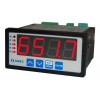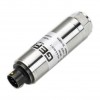Digital panel meters for displaying inputs from 4 wire ratiometric strain gauge sensors such as millivolt output pressure transducers and load cells. Digital displays for ratiometric strain gauge input with adjustable alarm outputs for setting off warning indicators or controlling process equipment.
Products
 SRP94 Large LED Process Display Panel Mount Indicator - Four digit reading digital indicator for monitoring the signal from mA, volts or mV output sensors with settable alarms for switching fans, pumps or valves.
SRP94 Large LED Process Display Panel Mount Indicator - Four digit reading digital indicator for monitoring the signal from mA, volts or mV output sensors with settable alarms for switching fans, pumps or valves.

